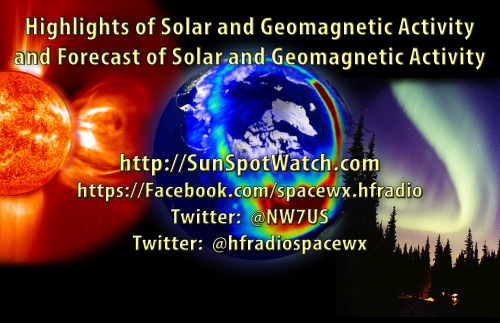The NW7US Beacon
RSS
Here is this week’s space weather and geophysical report, issued 2016 Jun 20 0550 UTC.
Highlights of Solar and Geomagnetic Activity 13 - 19 June 2016
Solar activity was at very low levels the majority of the period with low levels observed on 13 and 19 June due to a C3 flare at 13/0552 UTC from Region 2552 (N15, L=359, class/area Dao/150 on 11 June) and a C1 flare at 19/1158 UTC from Region 2558 (N13, L=215, class/area Cso/030 on 19 June). The majority of the B-class activity was caused by Region 2555 (S09, L=274, class/area Cao/080 on 17 June). No Earth-directed coronal mass ejections were observed during the period.
No proton events were observed at geosynchronous orbit.
The greater than 2 MeV electron flux at geosynchronous orbit was at normal to moderate levels throughout the period and briefly reached high levels on 19 June with a maximum flux of 1,030 pfu at 19/1640 UTC.
The geomagnetic field ranged from quiet to G2-Moderate storm levels. Solar wind conditions began the period under a waning positive polarity coronal hole high speed stream (CH HSS). Solar wind speeds decreased from approximately 620 km/s to around 420 km/s by midday on 14 June. Total field decreased from 8 nT to 4 nT. By late on 14 June, total field increased to 15 nT with the Bz component mostly southward near -14 nT while solar wind increased to a maximum of 772 km/s at 15/0410 UTC, indicative of a co-rotating interaction region followed by another positive polarity CH HSS. The geomagnetic field responded with quiet to active levels on 13 June, quiet to G2-Moderate storm levels on 14 June and quiet to G1-Minor storm levels on 15 June. By early on 16 June, total field decreased to around 6 nT with solar wind speeds in the 500-600 km/s range. These conditions continued until 19 June when solar wind speeds decreased to nominal levels. Quiet conditions were observed on 16 and 19 June with quiet to unsettled levels on 17-18 June.
Forecast of Solar and Geomagnetic Activity 20 June - 16 July 2016
Solar activity is expected to be at very low to low levels for the forecast period.
No proton events are expected at geosynchronous orbit.
The greater than 2 MeV electron flux at geosynchronous orbit is expected to be at normal to moderate levels with high levels likely on 20-22 June, 26 June-01 July, 04-07 July and again on 16 July due to CH HSS activity.
Geomagnetic field activity is expected to be at unsettled to active levels from 23-27 June, 02-03 July, 07-12 July and 14-15 July. G1-Minor storm levels are likely on 02-03 July and 11 July due to recurrent CH HSS activity.
Don’t forget to visit our live space weather and radio propagation web site, at: http://SunSpotWatch.com/
Live Aurora mapping is at http://aurora.sunspotwatch.com/
If you are on Twitter, please follow these two users: + https://Twitter.com/NW7US + https://Twitter.com/hfradiospacewx
Get the space weather and radio propagation self-study course, today. Visit http://nw7us.us/swc for the latest sale and for more information!
Check out the stunning view of our Sun in action, as seen during the last five years with the Solar Dynamics Observatory (SDO): https://www.youtube.com/watch?v=zXN-MdoGM9g
We’re on Facebook: http://NW7US.us/swhfr
